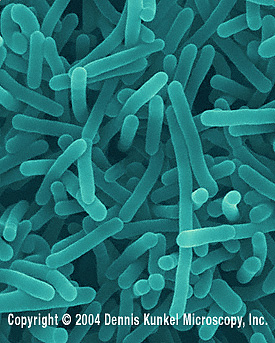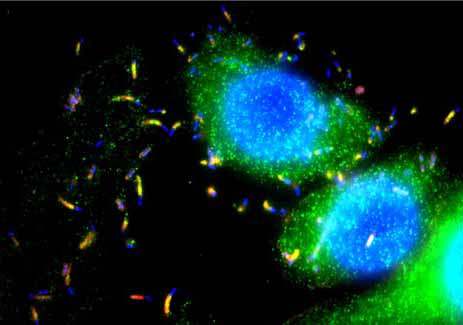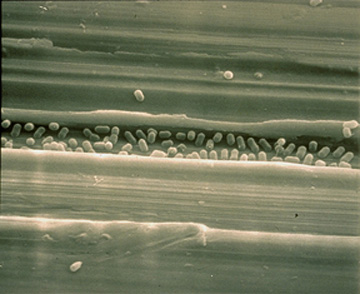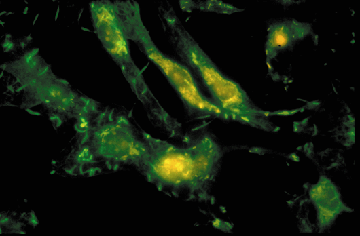Listeria
A Microbial Biorealm page on the genus Listeria

Classification
Higher order taxa:
Bacteria; Firmicutes; Bacilli; Bacillales; Listeriaceae; Listeria
Species:
Listeria monocytogenes, L. innocua, L. grayi, L. ivanovii
Description and Significance
Listeria are mainly soil bacteria, though as a pathogen they are food-borne. They are intracellular pathogens that use actin filaments within the host cell for their motility. L. monocytogenes is the causative agent of listeriosis.
Genome Structure
The genomes of both Listeria monocytogenes EGD-e and Listeria innocua, and Listeria monocytogenes str. 4b F2365 have been sequenced. The genome of Listeria monocytogenes EGD-e is 2,944,528 bp long with 2853 open reading frames and a G+C content of 39%. The genome of Listeria innocua is 3,011,209 bp long with 2973 open reading frames and a G+C content of 37%. The genome of Listeria monocytogenes str, 4b F2365 is 2905310 bp long with a G+C content of 38%. Surprisingly, many encoded proteins are similar to those of the soil bacterium Bacillus subtilis. L. monocytogenes has a single circular chromosome, while L. innocua contains an additional plasmid of 81,905 bp. There are also two other genomes that are currently being sequenced, Listeria monocytogenes str. 1/2a F6854, and Listeria monocytogenes str. 4b H7858. The ability of Listeria to inhabit a wide range of environments coincides with the presence of 331 genes encoding different transport proteins, comprising 11.6% of the total gene compliment of L. monocytogenes. Listeria also has an extensive regulatory repertoire occupying 7.3% of the total genome.
Cell Structure and Metabolism

Listeria are non spore-forming, nonbranching, Gram-positive rods that occur individually or form short chains. Listeria are able to produce adenosine triphosphate through a complete respiratory chain, and have several fermentation pathways. This coincides with their lifestyle as microaerophilic, facultative anaerobes. Listeria are intracellular pathogens that use host-produced actin filaments for motility within the host cell. The bacteria propel themselves through the cytoplasm of an infected cell by forming a "jet tail" of host actin behind them.
Ecology

Listeria colonies are small, smooth and blueish-gray. Their optimum growth temperature is between 30 and 37 degrees celsius, but growth can occur at temperatures as low as 4 degrees celsius, but the generation time is longer. Listeria is widely distributed throughout the environment, inhabiting soil, decaying vegetable matter, sewage, water, animal feed, fresh and frozen poultry, processed meats, raw milk, cheese, and humans. But primary habitats are considered to be soil and decaying vegetable matter, living as a saprophyte. Listeria can also survive in many extreme conditions that it encounters during its lifespan, such as high salt concentrations, high pH, and high temperature. Both pathogenic and innocuous forms of listeria have this ability. Listeria spp. also form biofilms, which allow them to attach to solid surfaces where they proliferate and become extremely difficult to remove.
Pathology

Listeria monocytogenes is the etiological agent of listeriosis. L. monocytogenes is a food-borne pathogen, which, as mentioned earlier, can survive normal refrigeration processes. It can cause severe disease in immunocompromised individuals, and pregnant women. Listeria is an intracellular pathogen where they co-opt the cell's machinery, and travel through the blood stream, once they make it through the gastrointestinal tract. After ingestion of contaminated food, Listeria migrates from the intestinal lumen to the central nervous system, and the fetoplacental unit. The clinical manifestations of listeriosis include meningitis, meningoencephalitis, septicemia, abortion, perinatal infection, and gastroenteritis. Listeria is capable of infecting macrophages, which acquire the pathogen through phagocytosis, or epithelial cells, which are infected when listeria induces cytoskeletal changes and plasma membrane extensions. But even with all of the problems that Listeria can cause to humans, it is now being researched as a cancer vaccine. This is because of its ability induce potent innate and adaptive immunity.
